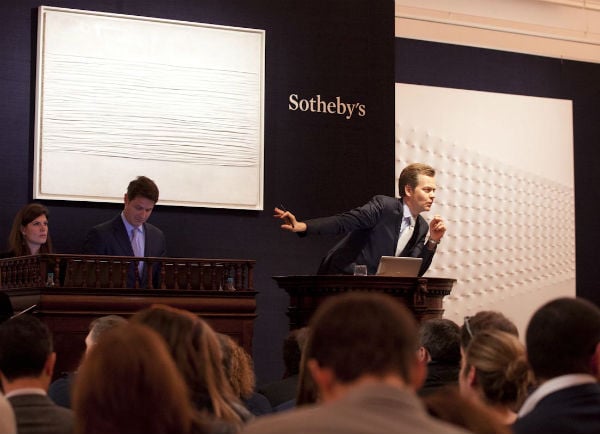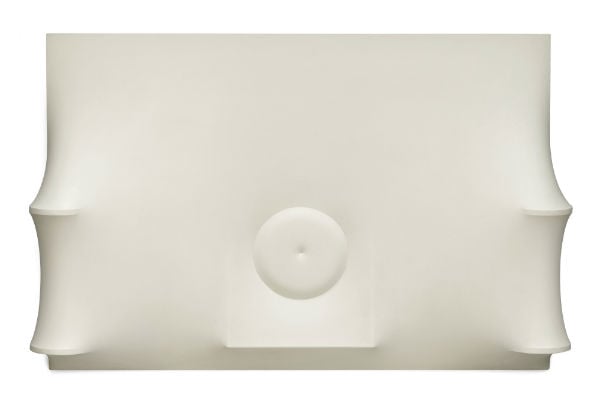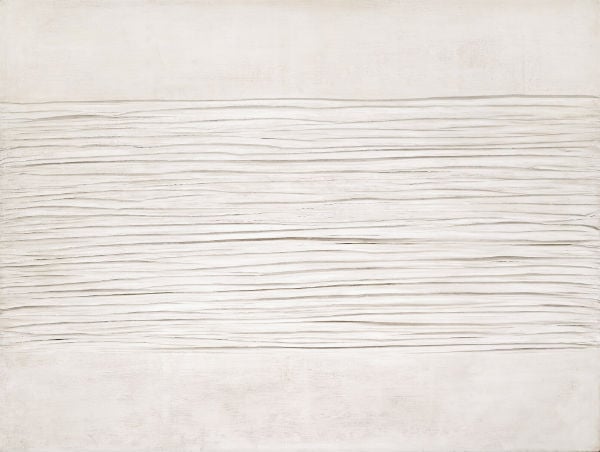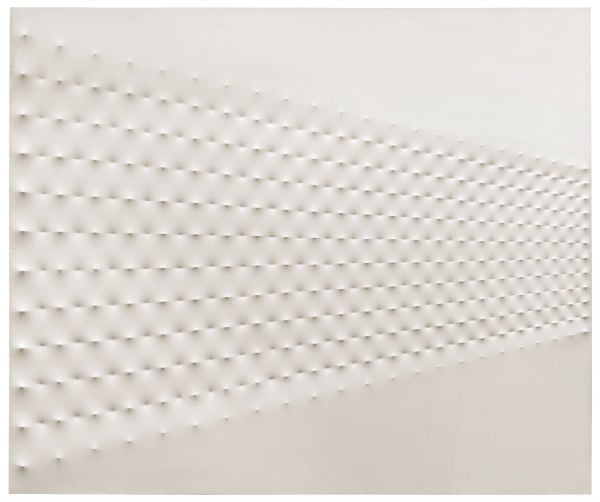Analysis
Strong Sales in London for Italian Postwar Market
A slew of records for Zero and Arte Povera.

A slew of records for Zero and Arte Povera.

Colin Gleadell


Italian sale at Sotheby’s London, October 2014.
Photo via: Sotheby’s.
Twentieth-century Italian art appeared to be more buoyant than international contemporary art in London last week as two successive sales at Christie’s and then Sotheby’s beat the previous record (£26.8 million at Christie’s last October) for a sale in this category.
On Thursday evening, Christie’s sold 49 of 53 lots, 94 percent of them, for £27.6 million, or $44 million—plumb in the middle of its £22–32 million presale estimate.
But the record lasted just 24 hours.

Agostino Bonalumi, Rosso (1969).
Photo: Courtesy Christie’s.
The following evening Sotheby’s took in £41.4 million, or $66.4 million, surpassing the £24–33.5 million presale estimate with ease, and selling 48 of the 49 lots, or 98 percent. Ten artists’ records were broken in all.
Twentieth-century Italian art has been on the up and up since 1999, when Sotheby’s devised it as a new sales category to win a collection of Italian art from Christie’s, and timed it to coincide with a festival of Italian culture in London. In 2002, their combined sales made £10.4 million. The record sale at Christie’s London sale last October paved the way for the auctioneer’s £38.4 million sale this February of a collection of primarily Italian Arte Povera. The consignors from Italy were thought to have been influenced not just by the buoyant market, but also by the Italian export laws which state that art made 50 years ago or more (i.e., up to 1964), if thought to be of national importance, is subject to export restrictions and therefore less valuable if kept in Italy.
In the run-up to last week’s sales, there was also an unprecedented number of postwar Italian art exhibitions in London, from Mario Merz at Pace, to Paolo Scheggi at Robilant + Voena. Also came announcements that two specialized dealers, Mazzoleni from Turin, and Tornabuoni from Paris, were to open galleries in London.

Agostino Bonalumi, Bianco (1966).
Courtesy Sotheby’s
The gathering crescendo then continued throughout the auctions. These were dominated by a select group of postwar artists, led, numerically speaking, by Lucio Fontana; 20 out of 20 works by him sold. The top Fontana was at Sotheby’s, where a white Concetto Spaziale Attese (1964) with 11 cuts was underbid by dealer Ezra Nahmad, before selling for £2.3 million, or $3.7 million, against a punchy £2.2–2.8 million estimate. Having successfully bought works by Fontana, Burri, and de Chirico at Christie’s the night before, Nahmad was demoted to the role of underbidder on three other of the top-selling Fontanas in the Sotheby’s sale. “I didn’t buy one thing,” said a bemused Nahmad, as he exited the salesroom.
The highest individual price paid in the Italian sales was at Sotheby’s, for an unusually large pleated canvas, Achrome (1958–59) by Piero Manzoni. After a smaller example sold on its low estimate for £2.3 million at Christie’s, it became clear that the big buyers were holding back for the main prize at Sotheby’s. Here, at least six bidders went for it over the £5 million low estimate, including Skarlet Smatana, the director of the George Economou collection; she stopped at £8 million, leaving it to two telephone bidders who took it to a record £12.6 million, or $20 million, including buyer’s premium, amidst thunderous applause. The price places Manzoni on a par with Fontana (record: $20.9 million), and of course he is much rarer, having died in 1963 at age 30. The previous record for Manzoni was $14.1 million set in New York in May 2013.
The second-highest price of the Italian sales was for the record £3.8 million, or $6.1 million, given at Sotheby’s by Sotheby’s Europe chair and Germany managing director Philipp Herzog von Württemberg, who outbid a posse of eager buyers, including New York and London gallery Dominique Lévy, for Enrico Castellani’s very large shaped white canvas, Superficie Bianca (1967), that had been estimated at £1–1.5 million. The previous record for Castellani was £1.85 million, or $2.85 million, set last October in London.

Piero Manzoni, Achrome (1958–59).
Photo: Courtesy Sotheby’s.
Lévy had just opened her new gallery in London’s Mayfair, with works by Castellani, Donald Judd, and Frank Stella, and she sold a monochrome red Castellani at the opening, before the auctions, for “a good price,” said director Lock Kresler. Ten works at auction by the 84-year-old Italian, who is recognized as an important member of the Zero group and the spacialism movement (Movimento Spaziale), threatened to swamp the market, but all of the works sold, mostly for double or triple the estimates. Other buyers and bidders for Castellani’s work were Milan dealer Nicolò Cardi, New York dealer Neal Meltzer, and art adviser Jude Hess.
London dealer Ben Brown, who at Frieze Masters was showing works on paper by the sometime–Arte Povera artist Alighiero Boetti also didn’t wait for the auctions, and sold a massive 12-panel Biro work by Boetti for over €2 million at the fair, hours before the first Italian sale began. He then made it to the Christie’s auction to witness Boetti’s nearly seven-foot-high Colonna (Column) (1968) sell for a record £2.4 million, or $3.9 million, to an American collector willing to pay more than the £1.5–2 million estimate for this classic Arte Povera sculpture made of paper doilies and iron.
Average prices for Boetti have more than trebled in the last two years, according to artnet Analytics, and last week 20 out of 23 Boettis were sold.

Alighiero Boetti, Colonna (Column), (1968).
Photo: Courtesy of Christie’s.
Brown went on to buy three works on paper by Boetti at Christie’s, but was outbid at Sotheby’s when a three-part Boetti watercolor, Aerei (1989), sold to an American phone bidder for a quadruple mid-estimate £470,500 or $754,541. Of the Boetti embroidered works on offer, a 1979 Mappa (of the world) at Sotheby’s from the Alessandro Grassi collection sold for £1.2 million, or $1.9 million, above the £700,000–900,000 estimate, to Jude Hess, while a later 1988 example belonging to artist Marc Quinn, had a hopeful £1 million low estimate, and sold just below that to realize a premium inclusive £1.1 million, or $1.8 million.
Slightly farther down the price scale, things were happening to Castellani’s fellow spacialist artist, Agostino Bonalumi, who died last year. Prior to that, his auction record was £223,250, set in Sotheby’s Lenz collection sale of Zero group–related works in 2010. Last week that price was exceeded three times. At Christie’s, a gray shaped canvas from 1969 sold above the £150,000–250,000 estimate to Nicolò Cardi for £302,500, or $482,185, and then a rare and large floor-based sculpture, Rosso (1969), sold within estimate for £386,500, or $616,000.
At Sotheby’s, a black shaped Bonalumi canvas, Nero (1966), sold above a £100,000–150,000 estimate for £206,500, or $331,000, against bidding from Jose Mugrabi. That’s always a sign that something is happening in an artist’s market, and sure enough, three lots later, a white six-foot-plus–wide shaped canvas, Blanco (1966), sold for a new record, £626,500, or $1 million, double the low estimate.
No Italian sales report would be complete without mention of the latest phenomenon. Paolo Scheggi, who died in 1971 at just 31 years of age, is an artist that few market watchers had spotted until last October, when one of his three-canvas-deep cut-out constructed works sold for £218,000 against a £20,000 estimate in London. Before last week’s auctions, London dealers Robilant + Voena exhibited Scheggi works at their gallery and at the Pavilion of Art & Design fair in London, where they made several sales in the £200,000–500,000 range.

Enrico Castellani, Superficie Bianca (1967).
Photo: Courtesy Sotheby’s.
At the auctions, four works by Scheggi were all sold, most at double the estimates. The top price was £422,500, or $677,563, bid over the phone at Sotheby’s against competition from Cardi and Jude Hess for Intersuperficie Blu – Opera 6 (1965). Significantly, another Scheggi in the sale, Intersuperficie Bianca (1964), which sold for double its estimate at £386,500, or $619,830, was underbid by Mugrabi, stalking the territory.